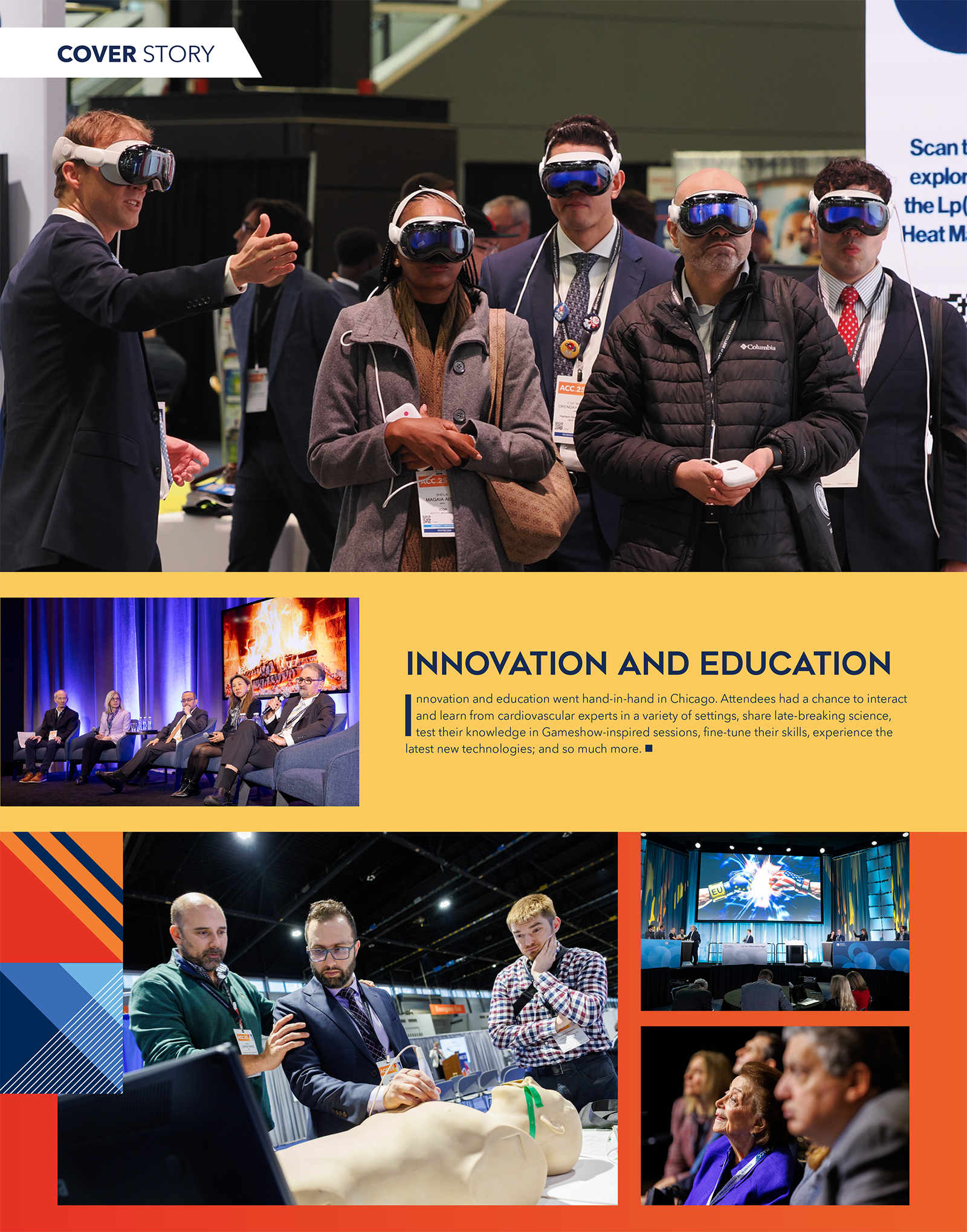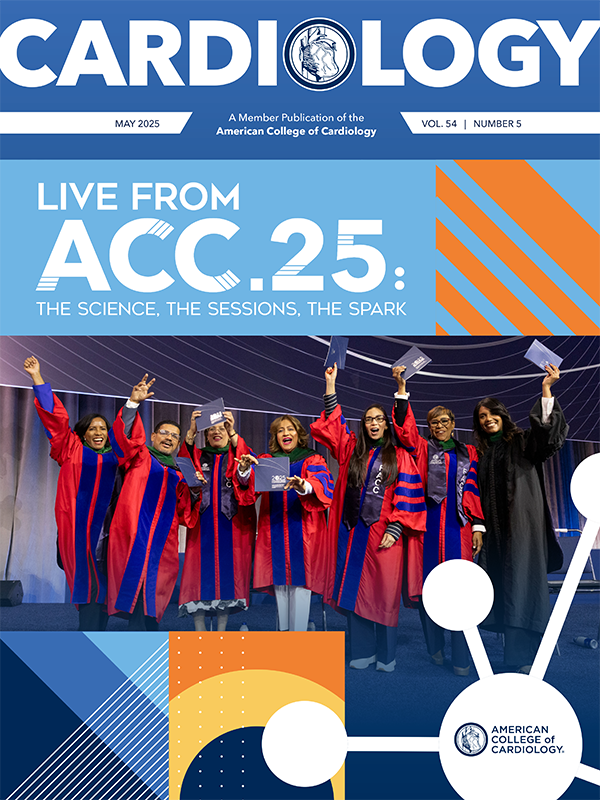Cover Story | Picture Perfect: ACC.25
Jump To: ACC.25 Science Spotlight | ACC.25 Science Presents New Applications For AI in the Clinical Setting









ACC.25 Science Spotlight
Science presented during ACC.25 holds the potential to shed light on new drugs and devices being tested and refine future research, along with bringing new insights to current treatment approaches and impact clinical practice. Here are quick recaps on some top science from the meeting.
In the double-blind STRIDE trial, semaglutide, vs. placebo, significantly improved walking distance, symptoms and quality of life in patients with symptomatic peripheral artery disease (PAD) and type 2 diabetes (T2D). Among 792 participants (median age 68 years, 25% women, 68% White, 50% with BMI <30 kg/m2,) with T2D and PAD with intermittent claudication (Fontaine stage IIa) plus an ankle-brachial index of ≤0.90 (mean 0.75) or toe-brachial index ≤0.70 (mean 0.48), once-weekly doses of subcutaneous semaglutide for 52 weeks was associated with a median improvement of 26 meters and an average improvement of 40 meters, representing a statistically significant 13% improvement at one year (estimated treatment ratio, 1.13). Improvement in maximum walking difference after five weeks cessation, quality of life as measured by VascuQoL-6 and improvement in pain-free walking distance were all significantly greater with semaglutide.
In SOUL, an oral formulation of semaglutide lowered the risk major adverse cardiovascular events by 14% at four years, with no change in safety profile, vs. placebo. The first study of cardiovascular benefits of an oral GLP-1 agonist, 9,650 patients with T2D, a glycated hemoglobin level of 6.5-10%, atherosclerotic cardiovascular disease and/or chronic kidney disease (CKD) were randomized to once-daily oral semaglutide at a maximum dose of 14 mg or placebo on top of standard care. About 27% of both arms were receiving SGLT2 inhibitors at baseline; mean age was 66, 29% women, about 70% White.
The composite primary endpoint of cardiovascular death, nonfatal myocardial infarction (MI) or stroke occurred in 12% and 13.8% of the semaglutide and placebo groups over a mean 47.5 months, translating to 3.1 and 3.7 events per 100 person-years, respectively, and a 14% relative risk reduction (p=0.006). The largest reduction was in nonfatal MI at 26%, followed by nonfatal stroke at 12% and cardiovascular death at 7%. No significant difference was observed in outcomes related to kidney function.
"There's been a huge [open] question among clinicians about whether these drugs are complementary and whether we should use one or the other or both," said the study's first author, Darren K. McGuire, MD, FACC. "The results showed no significant difference in outcomes between patients who took SGLT-2 inhibitors, who were likely to have more advanced disease, and those who did not, suggesting that the drugs can be safely used together and are complementary in their ability to reduce cardiovascular risk."
An analysis from SUMMIT showed that baseline estimated glomerular filtration rate (eGFR) did not impact the effect of tirzepatide on reducing major adverse heart failure (HF) events or enhancing health status among patients with obesity-related heart failure with preserved ejection fraction (HFpEF) and CKD. However, absolute risk reduction in primary events was numerically greater in patients with CKD.
Of the 731 patients with HFpEF and a BMI ≥30kg/m2 in SUMMIT, 60% had CKD. Examining outcomes in relation to eGFR as measured by creatine-based and cystatin-C based estimates, results showed HF severity was greater in those with CKD, including a twofold increase in risk of worsening HF events. Tirzepatide produced a decline in eGFR at 12 weeks with eGFR-creatinine (but not eGFR-cystatin C), and it led to an improvement in eGFR at 52 weeks in all patients (when assessed by cystatin C), but only in patients with CKD (when assessed by eGFR-creatinine).
In ZENITH, sotatercept, a first-in-class novel activin-signaling inhibitor, vs. placebo, led to a 76% lower risk of a composite of all-cause death, lung transplantation or hospitalization for worsening pulmonary arterial hypertension (PAH) in high-risk adults with PAH. The trial was stopped early based on efficacy results following a prespecified interim analysis.
Read more in JACC in a Flash and Journal Wrap. And visit ACC.org/ACC2025 for comprehensive news coverage and perspectives on the hottest Late-Breaking Clinical Trials and Featured Clinical Research studies, as well as access journal scans, trial summaries, video coverage and more.
Of 172 patients with WHO functional class III or IV PAH randomized to either standard care or add-on subcutaneous sotatercept starting at 0.3 mg/kg body weight and escalating to 0.7 mg/kg, 15 patients (17.4%) in the sotatercept and 47 patients (54.7%) in the standard care arms reached the primary endpoint, a composite of all-cause death, lung transplantation or hospitalization for worsening PAH (hazard ratio, 0.24; p<0.001).
Intensive control of systolic blood pressure (SBP) in U.S. adults ≥80 years taking antihypertensive agents is associated with a reduced risk of death from cardiovascular disease, supporting guidelines for intensive BP control, according to a brief report published in JACC and presented at ACC.25. Compared with an SBP 130-160 mmHg, the adjusted hazard ratio was 0.74 for treated SBP <130 mm Hg.
Microplastic exposure is associated with a higher prevalence of chronic noncommunicable diseases including hypertension, diabetes and stroke, according to research led by Sai Rahul Ponnana, MS, et al. A machine learning model found that microplastic concentration was a significant predictor of stroke prevalence in particular, comparable to factors such as minority race and lack of health insurance. The researchers note this study provides initial evidence linking microplastic exposure and an impact on cardiovascular health.
An unrelated study illustrated the ubiquity of microplastics in everyday life and the possible cardiovascular risk they pose. Researchers Eesha Nachnani, et al., found microplastics in 100% of analyzed blood samples, and that a significant proportion of patients (58%-100%) had microplastics within their arterial plaques. Results showed a strong correlation between presence of microplastics in plaques and increased risk of MI) stroke and death. Patients with acute coronary syndromes, particularly those with acute MI, had higher concentrations of microplastics in their system.
In a registry-based study conducted in Denmark, acute respiratory syncytial virus (RSV) infection in adults ≥65 was significantly associated with an increased risk of cardiovascular events. In 2,655 adults (mean age 78), there was a 4.4-fold increase in HF hospitalization, an 8.1-fold increase in ischemic stroke and a 3.2-fold increase in MI, as well as a 5-fold increase in major adverse cardiovascular events and a 6.3-fold increase in any cardiovascular event. Of all cardiovascular events, 68% occurred during the same hospitalization as the RSV diagnosis.

ACC.25 Science Presents New Applications For AI in the Clinical Setting
The latest science coming out of ACC.25 illuminated new approaches in how artificial intelligence (AI) can be used to improve the efficiency of cardiovascular care, expand the reach into underserved communities and more.
Studies examined the latest trends in application such as AI assistance for risk stratification in the emergency department (ED), clinical trial enrollment, ultrasound capture and echocardiogram analysis.
Deep Learning ECG Model For ED Risk Stratification
A late-breaking clinical trial presented Saturday and simultaneously published in the European Heart Journal delved into the use of a deep learning electrocardiogram (ECG) model in the ED for risk stratification on coronary revascularization need.
This study was the first of its kind to be designed for broad applicability in a general EP population. Antonius Büscher, MD, et al., used data from 144,691 ED visits (median age 60 years, 53% women, 0.6% revascularization) from a single U.S. center to train a convolutional neural network model in categorizing risk into three groups: low, immediate and high.
The model was then tested on an additional cohort of 35,995 visits and compared against clinician ECG interpretation and cardiac troponin T (TnT), where it performed better than clinicians and similarly to TnT testing.
In an external validation performed on a data set of 18,673 ED visits in Europe (median age 55 years, 49% women, 1.5% revascularization, 1% with type 1 myocardial infarction [MI]), the model outperformed both clinician interpretation and cardiac TnT testing, achieving an area under the receiver operating characteristic curve of 0.91.
In determining both revascularization and type 1 MI, the model continued to outperform clinicians and was competitive with high-sensitivity TnT with a higher specificity but lower sensitivity, indicating what investigators called "complementary diagnostic information."
"A common goal with these types of models is to make the most use of the data that we have, and to complement physicians' clinical reasoning by picking up some nuances in the data that might be obscure to the human eye," Büscher said. "I think we are still at the beginning of this field, but in the not too far future, these types of models will be used as routine diagnostic tests."
Improving Access to Clinical Trial Participation
Another late-breaking clinical trial shared how implementation of digital health technologies can help reach patients blocked from clinical trial participation due to either lack of involvement by community physicians and infrastructure or challenges in participant recruitment and retention.
With the Health360x™ Registry, a clinical research platform service that integrates social determinants of health data and electronic health records with AI and machine learning, barriers at the patient, provider and practice levels were targeted to improve clinical trial recruitment and retention in predominantly African American, Latinx and rural communities.
The registry currently has 11,374 participants (median age 68 years, 85% Black, 8% White, 5% Hispanic/Latinx, 0.5% Asian, 59% women) enrolled in seven studies – five sponsored by the National Institutes of Health, one sponsored by industry, and one quality improvement project – with 100% screening success.
Elizabeth O. Ofili, MD, MPH, FACC, et al., said the key to success was in "meeting sites where they are," and measuring site compliance, H360x.ai Chatbot usage and patient satisfaction.
Future steps will focus on the automation of AI and machine learning support for trial management, including site initiation and training to reduce burden on participating practices and improve site activation and recruitment.
AI Assistance in Imaging
Additionally, two Monday presentations looked at AI use to aid novice sonographers in obtaining echocardiogram views and cardiologists in reporting severe aortic stenosis (AS), respectively.
The first was an international, multicenter, prospective noninferiority trial, which evaluated whether nurses with no prior ultrasound experience could obtain diagnostic-level acquisitions or 10 echocardiographic views with assistance from the AI software HeartFocus.
Trained on a total of 1,483 patients and 1,204,113 ultrasound images, HeartFocus has a combination of one deep-learning algorithm for view detection, 10 deep-learning algorithms for live guidance and two recording algorithms. The program indicates where to hold the probe while auto-recording results.
Seeking to determine whether novice ultrasound exams were high-quality enough to analyze left ventricle size and function, right ventricle size, and presence of nontrivial pericardial effusion, the trial included seven experts and eight novice nurses conducting sequential exams on 240 patients (48.8% women, 70.4% with cardiac abnormalities, 18.3% with implanted cardiac devices). Five outside expert cardiologists then reviewed the 480 images.
No difference in quality was found between novice and expert exams, and novices performed high quality exams starting with their first exam. With these findings, Caroline Ong, MD, FACC, et al., said HeartFocus is a "safe and reliable" integration into standard practice.
The second study explored AI assistance in cardiologist reporting of AS with the EchoSolv-AS model, now cleared by the U.S. Food and Drug Administration.
David A. Playford, MBBS, PhD, FACC, et al., used AI to detect AS in 200 echocardiograms and compared results to clinician findings. Secondary endpoints included reading time, referral rates, cardiologist concordance and cardiologist sensitivity.
The AI model was 100% accurate at detecting severe AS, while clinicians misdiagnosed severe AS 6-54% of the time, with an overall error rate of 20.6%. Most misdiagnoses were of low-gradient severe AS.
Despite the 100% accuracy of the model, no cardiologist consistently accepted AI recommendations. The researchers describe these results as a signal that lack of trust will be a major barrier in AI integration moving forward.
Looking for more on AI? Visit ACC's AI Resource Center.
Clinical Topics: Noninvasive Imaging, Echocardiography/Ultrasound
Keywords: Cardiology Magazine, ACC Publications, ACC25, ACC Annual Scientific Session, Semaglutide, Clinical Trials as Topic, Artificial Intelligence, Echocardiography
